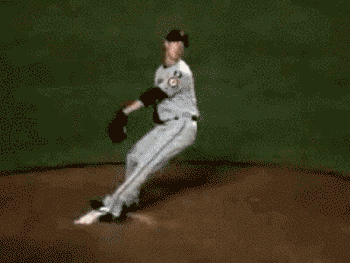You remember why they called him The Freak, he had come into the league weighing 170 pounds soaking wet and stalling a somewhat diminutive 5'11 for baseball pitcher standards. Yet, when he unleashed his fastball out of his whirling dervish of a pitching motion, he could reach speeds of up to 98 mph.
That was 2008, in 2012 Tim Lincecum's velocity sits at about 90-92 mph and critics are starting to wonder if the amount of pitching he's done the past 4 years has worn his arm down and caused a decrease in velocity.
I think we can actually explain this in a subtle change in Tim's pitching motion. After his first Cy Young season, critics began to tell Lincecum that although he throws heat, his motion caused a large gap in the pitcher's fielding ability. Because of the enormous rotation Tim had in his motion, his momentum would regularly cause him to fall to his left after pitching and with his right side and back to the hitter.
After this correction was made, and Tim slightly altered how he came out of the windup so he would be in a better position defensively, you see a dip in his velocity.
look at this side by side comparison of 2008 Timmy with 2012 Timmy

As you can see the 2008 Timmy on your left, has dipped his head and is rotating more than the 2012 Timmy. Although 2008 Timmy may have trouble defensively after the pitch, the velocity after this screen shot was taken was 96 mph. The velocity of the pitch after the 2012 screen shot was taken was 91 mph. Additionally in the clip of the 2008 Timmy, his right leg swings back over and falls to his left thus giving him a 180 degree spin from the windup.
You can see by the red lines, that the angle of Tim's body is much greater in 2008 adding to the torque and rotation that Tim is putting on the ball. Because of his size, Timmy's velocity really only comes from two places, his legs, and his trunk rotation. Obviously in this picture you can see that the rotation has taken a back seat thus sacrificing some velocity to the fastball.
Now lets turn to his legs, much of the power from the legs comes from how Tim makes a stride pointing towards 3rd base and plants his foot as far forward as possible.
Take a look at 2008 Timmy's foot plant

as you can see his foot plants at frame 92 and instantly you see the rotation to the right that allows him to add even more velocity to the ball after the plant. The rotation is evident because you see his momentum taking him to the left after the plant.
Here's a look at 2010, where Tim had already lost 3-4 mph on his fastball

Here the foot plant at frame 26 is not followed by more rotation and it simply stops his momentum, and forces Tim to come up with the rest of the power from his arm. Not only is this not his game, this could be detrimental to his arm and takes the brunt of the force away from his legs and rotation, and puts it squarely on his elbow. There is no momentum to the left because all of Tim's momentum was moving forward.
Now this may seem like what you'd want to do seeing as you want the ball to move forward and not to the left. While that might be true for conventional pitchers, we all know that Timmy is far from conventional. The addition of torque to his leg strength greatly adds to his velocity and takes stress off his arm.
After he made this change his velocity had only dropped a few mph, but because the stress was now mostly on his arm, the arm could wear down and that's where you see the large drop in velocity.
** UPDATE **
Seems Timmy has been rotating more as of yesterday, and his velocity went up to 93 mph although he had another horrendous start. There was no control over any of his pitches, but the life on the fastball, the movement on the change-up were all there. Its still a step in the right direction, but it wont come overnight.
Laws of the Day
the Giants have scored 29 runs in the first 5 games for a 5.8 run/game average but opponents have scored 34 runs against Giants' pitching.
Last year Giants averaged 3.52 runs/game
No comments:
Post a Comment